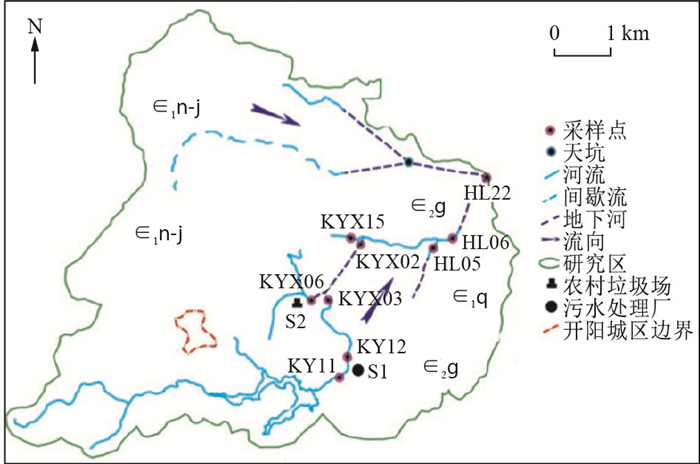Identification of indicators of antibiotic pollution in typical karst groundwater in southwestern China
-
摘要:
我国南方岩溶地区是全球三大岩溶集中分布区之一, 由于岩溶地区独特的含水层结构, 其地下水极易受到地表污染。为了探明岩溶地下水中抗生素污染空间分布的主控因素, 厘清抗生素浓度与水化学参数的相关关系, 进而识别岩溶地区水环境中抗生素污染的指示因子, 以西南典型岩溶地下河系统为研究对象, 利用超高效液相色谱串联质谱联用仪(UPLC-MS/MS)分析了35种抗生素浓度。结果表明: 研究区共检出了30种抗生素, 包括3种四环素类(< 检出限(MDL)~421 ng/L)、5种大环内酯类(28.3~884 ng/L)、9种磺胺类(2.50~30 ng/L)和13种喹诺酮类(19.5~1 807 ng/L)。其中, 大环内酯类和喹诺酮类抗生素是研究区检出的主要抗生素, 其空间分布特征主要受污染源和稀释作用控制。研究区水化学类型包括HCO3-Ca·Mg型和HCO3-Ca·Na·Mg型, 抗生素浓度在不同的水化学类型中存在显著差异, HCO3-Ca·Na·Mg型水样中抗生素浓度显著高于HCO3-Ca·Mg型(2~10倍)(Mann-Whitney检验,
p < 0.05)。同时, Pearson相关性分析结果表明, 三氮(硝氮、亚硝氮与氨氮浓度之和)、总有机碳(TOC)、Na+、Cl-浓度与单一抗生素浓度、不同种类抗生素浓度、抗生素总浓度均呈显著正相关(r =0.81~0.99,p < 0.05,N =7~8)。相比三氮、TOC和Na+, Cl-在环境中性质更稳定, 是岩溶地区地下水系统中更可靠的抗生素污染指示因子。本研究为受县级污水处理厂和农村生活废水排放影响的岩溶地区抗生素污染识别与污染预测提供了理论依据。Abstract:Objective The karst area in southwestern China is one of the three concentrated karst distribution areas in the world. Karst groundwater is highly susceptible to pollution from the surface due to the unique structure of aquifers.
Methods To investigate the dominant factors influencing the spatial distribution of antibiotic pollution, clarify the correlation between antibiotics and hydrochemical parameters, and then identify the indicators of antibiotic pollution in karst groundwater systems, a typical karst groundwater system in southwestern China was selected as the research object. Thirty-five antibiotics were analysed using ultra performance liquid chromatography tandem mass spectrometry (UPLC-MS/MS).
Results The results showed that a total of thirty antibiotics were detected in the study area, including 3 tetracyclines (< MDL -421 ng/L), 5 macrolides (28.3-884 ng/L), 9 sulfonamides (2.50-30 ng/L) and 13 quinolones (19.5-1 807 ng/L).Among them, macrolides and quinolones were the dominant antibiotics in the study area, whose spatial distribution was dominated by pollution sources and dilution effects. The results of Pearson correlation analysis showed that the concentrations of inorganic nitrogen (the sum of NH4+-N, NO2--N and NO3--N), total organic carbon (TOC), Na+ and Cl- were significantly positively correlated with the concentration of individual antibiotics, the concentration of various antibiotic species, and the total concentration of antibiotics (
r =0.81-0.99,p < 0.05,N =7-8). With more stable properties than inorganic nitrogen, TOC and Na+, Cl- is a more reliable indicator of antibiotic pollution in groundwater in karst areas.Conclusion This study provides a theoretical basis for the identification and prediction of antibiotic pollution in karst areas affected by county-level wastewater treatment plants (WWTPs) and rural domestic wastewater discharges.
-
Key words:
- antibiotics /
- indicator /
- karst groundwater /
- spatial distribution /
- hydrochemistry /
- southwestern China
-
-
[1] LEI M, GAO Y, JIANG X. Current status and strategic planning of sinkhole collapses in China[M]. Cham: Engineering Geology for Society and Territory, Springer, 2015: 529-533. [2] 朱常坤, 基于信息熵的岩溶水监测网优化: 以徐州市典型水源地为例[J]. 地质科技通报, 2022, 41(1): 168-176. doi: 10.19509/j.cnki.dzkq.2022.0030ZHU C K. Optimization of karst water monitoring network based on information entropy: A case study in typical groundwater source sites in Xuzhou[J]. Bulletin of Geological Science and Technology, 2022, 41(1): 168-176. (in Chinese with English abstract) doi: 10.19509/j.cnki.dzkq.2022.0030 [3] 罗维均, 杨开萍, 王彦伟, 等. 喀斯特地区不同岩土组构对岩溶碳通量的影响[J]. 地质科技通报, 2022, 41(3): 208-214. doi: 10.19509/j.cnki.dzkq.2022.0088LUO W J, YANG K P, WANG Y W, et al. Influence of different rock-soil fabrics on carbonate weathering carbon sink flux in karst regions[J]. Bulletin of Geological Science and Technology, 2022, 41(3): 208-214. (in Chinese with English abstract) doi: 10.19509/j.cnki.dzkq.2022.0088 [4] DARNAULT C J G. Karst aquifers: Hydrogeology and exploitation[A]//Anon. Proceedings of the overexploitation and contamination of shared groundwater resources[C]. Netherlands: Springer, 2008: 203-226. [5] 郎赟超. 喀斯特地下水文系统物质循环的地球化学特征: 以贵阳市和遵义市为例[D]. 贵阳: 中国科学院地球化学研究所, 2005.LANG Y C. Geochemical characteristics of cycling of substances in karst ground water system: A case study from Guiyang and Zunyi Cities, China[D]. Guiyang: Institute of Geochemistry, Chinese Academy of Sciences, 2005. (in Chinese with English abstract) [6] KALHOR K, GHASEMIZADEH R, RAJIC L, et al. Assessment of groundwater quality and remediation in karst aquifers: A review[J]. Groundwater for Sustainable Development, 2019, 8: 104-121. doi: 10.1016/j.gsd.2018.10.004 [7] XIANG S, WANG X, MA W, et al. Response of microbial communities of karst river water to antibiotics and microbial source tracking for antibiotics[J]. Science of the Total Environment, 2020, 706: 135730. doi: 10.1016/j.scitotenv.2019.135730 [8] 刘元晴, 文冬光, 吕琳, 等. 沂蒙山区典型断陷盆地岩溶地下水系统特征: 以莱芜盆地为例[J]. 地质科技通报, 2022, 41(1): 157-167. doi: 10.19509/j.cnki.dzkq.2022.0013LIU Y Q, WEN D G, LV L, et al. Characteristics of karst groundwater flow systems of typical faulted basins in Yimeng Mountain area: A case study of Laiwu Basin[J]. Bulletin of Geological Science and Technology, 2022, 41(1): 157-167. (in Chinese with English abstract) doi: 10.19509/j.cnki.dzkq.2022.0013 [9] HUANG F, ZOU S, DENG D, et al. Antibiotics in a typical karst river system in China: Spatiotemporal variation and environmental risks[J]. Science of the Total Environment, 2019, 650: 1348-55. doi: 10.1016/j.scitotenv.2018.09.131 [10] HUANG H, LIU H, XIONG S, et al. Rapid transport of organochlorine pesticides(OCPs) in multimedia environment from karst area[J]. Science of the Total Environment, 2021, 775: 145698. doi: 10.1016/j.scitotenv.2021.145698 [11] ZAINAB S M, JUNAID M, XU N, et al. Antibiotics and antibiotic resistant genes(ARGs) in groundwater: A global review on dissemination, sources, interactions, environmental and human health risks[J]. Water Research, 2020, 187: 116455. doi: 10.1016/j.watres.2020.116455 [12] 孔慧敏, 赵晓辉, 徐琬, 等. 我国地下水环境抗生素赋存现状及风险评价[J]. 环境工程, 2023, 41(2): 219-226. https://www.cnki.com.cn/Article/CJFDTOTAL-HJGC202302028.htmKONG H M, ZHAO X H, XU W, et al. Occurrence and risk assessment of antibiotics in groundwater environment in China[J]. Environmental Engineering, 2023, 41(2): 219-226. (in Chinese with English abstract) https://www.cnki.com.cn/Article/CJFDTOTAL-HJGC202302028.htm [13] 剧泽佳, 付雨, 赵鑫宇, 等. 喹诺酮类抗生素在城市典型水环境中的分配系数及其主要环境影响因子[J]. 环境科学, 2022, 43(9): 4543-4555. https://www.cnki.com.cn/Article/CJFDTOTAL-HJKZ202209014.htmJU Z J, FU Y, ZHAO X Y, et al. Distribution coefficient of QNs in urban typical water and its main environmental influencing factors[J]. Environmental Science, 2022, 43(9): 4543-4555. (in Chinese with English abstract) https://www.cnki.com.cn/Article/CJFDTOTAL-HJKZ202209014.htm [14] KLEIN E Y, VAN BOECKEL T P, MARTINEZ E M, et al. Global increase and geographic convergence in antibiotic consumption between 2000 and 2015[J]. Proceedings of the National Academy of Sciences USA, 2018, 115(15): 3463-3470. [15] ZHANG Q Q, YING G G, PAN C G, et al. Comprehensive evaluation of antibiotics emission and fate in the river basins of China: Source analysis, multimedia modeling, and linkage to bacterial resistance[J]. Environmental Science & Technology, 2015, 49(11): 6772-6782. [16] KVMMERER K. Antibiotics in the aquatic environment: A review(Part I)[J]. Chemosphere, 2009, 75(4): 417-434. doi: 10.1016/j.chemosphere.2008.11.086 [17] 彭聪, 巴俊杰, 胡芬, 等. 广西会仙岩溶湿地典型抗生素污染特征及生态风险评估[J]. 环境科学学报, 2019, 39(7): 2207-2217. https://www.cnki.com.cn/Article/CJFDTOTAL-HJXX201907015.htmPENG C, BA J J, HU F, et al. Typical antibiotic pollution characteristics and ecological risk assessment of Huixian karst wetland in Guangxi, China[J]. Journal of Environmental Science, 2019, 39(7): 2207-2217. (in Chinese with English abstract) https://www.cnki.com.cn/Article/CJFDTOTAL-HJXX201907015.htm [18] ZHANG B, QIN S, GUAN X, et al. Distribution of antibiotic resistance genes in karst river and its ecological risk[J]. Water Research, 2021, 203: 117507. doi: 10.1016/j.watres.2021.117507 [19] 侯伟, 孙莉, 杨晓, 等. 城市供水水源中抗生素抗性基因污染及其在饮用水厂的去除研究进展[J]. 环境污染与防治, 2022, 44(4): 525-528. https://www.cnki.com.cn/Article/CJFDTOTAL-HJWR202204019.htmHOU W, SUN L, YANG X, et al. Advances of researches on antibiotic resistance genes pollution in urban water supply sources and removal in drinking water plants[J]. Environmental Pollution and Prevention, 2022, 44(4): 525-528. (in Chinese with English abstract) https://www.cnki.com.cn/Article/CJFDTOTAL-HJWR202204019.htm [20] DI CESARE A, ECKERT E M, TERUGGI A, et al. Constitutive presence of antibiotic resistance genes within the bacterial community of a large subalpine lake[J]. Molecular Ecology, 2015, 24(15): 3888-3900. doi: 10.1111/mec.13293 [21] QIN L T, PANG X R, ZENG H H, et al. Ecological and human health risk of sulfonamides in surface water and groundwater of Huixian karst wetland in Guilin, China[J]. Science of the Total Environment, 2020, 708: 134552. doi: 10.1016/j.scitotenv.2019.134552 [22] ZOU S, HUANG F, CHEN L, et al. The occurrence and distribution of antibiotics in the karst river system in Kaiyang, Southwest China[J]. Water Science and Technology(Water Supply), 2018, 18(6): 2044-2052. [23] 潘维艳, 邢立亭, 于苗, 等. 岩溶地下水中抗生素污染现状和特征研究综述[J]. 地下水, 2021, 43(2): 5-10. https://www.cnki.com.cn/Article/CJFDTOTAL-DXSU202102003.htmPAN W Y, XING L T, YU M. Review on the pollution situation and behavior of antibiotics in the karst groundwater system[J]. Groundwater, 2021, 43(2): 5-10. (in Chinese with English abstract) https://www.cnki.com.cn/Article/CJFDTOTAL-DXSU202102003.htm [24] LYU J, YANG L, ZHANG L, et al. Antibiotics in soil and water in China: A systematic review and source analysis[J]. Environmental Pollution, 2020, 266: 115147. doi: 10.1016/j.envpol.2020.115147 [25] DODGEN L K, KELLY W R, PANNO S V, et al. Characterizing pharmaceutical, personal care product, and hormone contamination in a karst aquifer of southwestern Illinois, USA, using water quality and stream flow parameters[J]. Science of the Total Environment, 2017, 578: 281-289. doi: 10.1016/j.scitotenv.2016.10.103 [26] SHI H, YANG Y, LIU M, et al. Ecological and human health risk of sulfonamides in surface water and groundwater of Huixian karst wetland in Guilin, China[J]. Science of the Total Environment, 2020, 708: 134552. doi: 10.1016/j.scitotenv.2019.134552 [27] YAN C, YANG Y, ZHOU J, et al. Antibiotics in the surface water of the Yangtze Estuary: Occurrence, distribution and risk assessment[J]. Environmental Pollution, 2013, 175: 22-29. doi: 10.1016/j.envpol.2012.12.008 [28] XU Y, GUO C, LUO Y, et al. Occurrence and distribution of antibiotics, antibiotic resistance genes in the urban rivers in Beijing, China[J]. Environmental Pollution, 2016, 213: 833-840. doi: 10.1016/j.envpol.2016.03.054 [29] XUE Q, QI Y J, LIU F. Ultra-high performance liquid chromatography-electrospray tandem mass spectrometry for the analysis of antibiotic residues in environmental waters[J]. Environmental Science and Pollution Research, 2015, 22(21): 16857-16867. doi: 10.1007/s11356-015-4900-1 [30] CHEN L, LANG H, LIU F, et al. Presence of antibiotics in shallow groundwater in the northern and southwestern regions of China[J]. Groundwater, 2018, 56(3): 451-457. doi: 10.1111/gwat.12596 [31] FU C, XU B, CHEN H, et al. Occurrence and distribution of antibiotics in groundwater, surface water, and sediment in Xiong'an New Area, China, and their relationship with antibiotic resistance genes[J]. Science of the Total Environment, 2022, 807: 151011. doi: 10.1016/j.scitotenv.2021.151011 [32] 童蕾, 姚林林, 刘慧, 等. 抗生素在地下水系统中的环境行为及生态效应研究进展[J]. 生态毒理学报, 2016, 11(2): 27-36. https://www.cnki.com.cn/Article/CJFDTOTAL-STDL201602005.htmTONG L, YAO L L, LIU H, et al. Review on the environmental behavior and ecological effect of antibiotics in groundwater system[J]. Acta Ecotoxicology, 2016, 11(2): 27-36. (in Chinese with English abstract) https://www.cnki.com.cn/Article/CJFDTOTAL-STDL201602005.htm [33] REIS A C, KOLVENBACH B A, NUNESB O C, et al. Biodegradation of antibiotics: The new resistance determinants(part Ⅱ)[J]. New Biotechnology, 2020, 54: 13-27. doi: 10.1016/j.nbt.2019.08.003 [34] CHIFFRE A, DEGIORGI F, BULETE A, et al. Occurrence of pharmaceuticals in WWTP effluents and their impact in a karstic rural catchment of Eastern France[J]. Environmental Science and Pollution Research, 2016, 23(24): 25427-25441. doi: 10.1007/s11356-016-7751-5 [35] GUO F, WANG Y, PENG J, et al. Occurrence, distribution, and risk assessment of antibiotics in the aquatic environment of the karst plateau wetland of Yangtze River Basin, southwestern China[J]. International Journal of Environmental Research and Public Health, 2022, 19(12): 7211. doi: 10.3390/ijerph19127211 [36] 庞园, 曾慧, 张明珠, 等. 流溪河流域地下水三氮分布特征及影响因素分析[J]. 人民珠江, 2021, 42(12): 17-23. https://www.cnki.com.cn/Article/CJFDTOTAL-RMZJ202112001.htmPANG Y, ZENG H, ZHANG M Z, et al. Analysis of distribution and influencing factors of three-nitrogen in groundwater of the Liuxi River Basin[J]. People's Pearl River, 2021, 42(12): 17-23. (in Chinese with English abstract) https://www.cnki.com.cn/Article/CJFDTOTAL-RMZJ202112001.htm [37] 陈劲松, 周金龙, 魏兴, 等. 新疆喀什噶尔河流域平原区地下水"三氮"含量分布特征及影响因素分析[J]. 环境化学, 2020, 39(11): 3246-3254. https://www.cnki.com.cn/Article/CJFDTOTAL-HJHX202011030.htmCHEN J S, ZHOU J L, WEI X, et al. Spatial distribution and influencing factors of "three-nitrogen" of groundwater in the plain of Kashgar River Basin, Xinjiang[J]. Environmental Chemistry, 2020, 39(11): 3246-3254. (in Chinese with English abstract) https://www.cnki.com.cn/Article/CJFDTOTAL-HJHX202011030.htm [38] KUYPERS M M M, MARCHANT H K, KARTAL B, et al. The microbial nitrogen-cycling network[J]. Nature Reviews Microbiology, 2018, 16(5): 263-276. doi: 10.1038/nrmicro.2018.9 [39] LIU Y, LIU C, NELSON W C, et al. Effect of water chemistry and hydrodynamics on nitrogen transformation activity and microbial community functional potential in hyporheic zone sediment columns[J]. Environmental Science & Technology, 2000, 51(9): 4877-4886. [40] 刘鑫, 左锐, 王金生, 等. 地下水位波动带三氮迁移转化过程研究进展[J]. 水文地质工程地质, 2021, 48(2): 27-36. https://www.cnki.com.cn/Article/CJFDTOTAL-SWDG202102004.htmLIU X, ZUO R, WANG J S, et al. Advances in researches on ammonia, nitrite and nitrate on migration and transformation in the groundwater level fluctuation zone[J]. Hydrogeology Engineering Geology, 2021, 48(2): 27-36. (in Chinese with English abstract) https://www.cnki.com.cn/Article/CJFDTOTAL-SWDG202102004.htm [41] 王巧莲, 蒋勇军, 陈宇. 岩溶流域地下水TOC输出及影响因素分析: 以重庆丰都雪玉洞地下河流域为例[J]. 环境科学, 2016, 37(5): 1788-1797. https://www.cnki.com.cn/Article/CJFDTOTAL-HJKZ201605025.htmWANG Q L, JIANG Y J, CHEN Y. Export of total organic carbon(TOC) from karst watershed and its influencing factors: An example from Xueyudong underground river system, Chongqing[J]. Environmental Science, 2016, 37(5): 1788-1797. (in Chinese with English abstract) https://www.cnki.com.cn/Article/CJFDTOTAL-HJKZ201605025.htm [42] GROS M, CATALAN N, MAS-PLA J, et al. Groundwater antibiotic pollution and its relationship with dissolved organic matter: Identification and environmental implications[J]. Environmental Pollution, 2021, 289: 117927. doi: 10.1016/j.envpol.2021.117927 [43] 郭芳, 姜光辉, 袁道先. 南方岩溶区地下河主要离子浓度变化趋势分析[J]. 水资源保护, 2008, 24(1): 16-19. https://www.cnki.com.cn/Article/CJFDTOTAL-SZYB200801008.htmGUO F, JIANG G H, YUAN D X. Change of major ions concentration in subterranean river in karst areas in South China[J]. Water Resources Protection, 2008, 24(1): 16-19. (in Chinese with English abstract) https://www.cnki.com.cn/Article/CJFDTOTAL-SZYB200801008.htm -





 下载:
下载:








